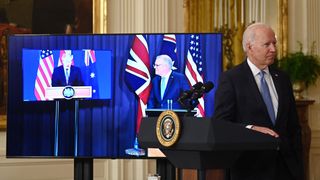Before the AUKUS announcement, evidence that the Biden administration was prioritizing the Indo-Pacific region was scant.
Sure, the administration talked a lot about China, but President Joe Biden mostly cast this as a long-term global contest for who would win the 21st century focused mainly on competing political systems and technology governance.
Administration officials showed little sense of urgency about competition in the Indo-Pacific, the region where China has the strongest advantages.
The Pentagon initially sought to dissolve the Pacific Deterrence Initiative, a program intended to drive funds to US Indo-Pacific Command for pressing regional needs, into future-oriented military modernization accounts. It took almost six months for a cabinet-level official to visit Southeast Asia.
The creation of the enhanced trilateral security partnership called AUKUS, involving Australia, the US and the UK, changes this narrative, with Washington doing something new and unexpected to empower a key regional ally.
The AUKUS launch was the first time in Biden's presidency that he has been clear about the importance to the US of the deteriorating strategic environment in the Indo-Pacific.
Not only has the US committed to sharing nuclear-powered submarine technology, something that it has only shared once before, the manner of the announcement suggests that AUKUS is intended as a strong immediate signal of deterrence to China.
Indeed, the AUKUS launch was the first time in Biden's presidency that he has been clear about the importance to the US of the deteriorating strategic environment in the Indo-Pacific.
At last week's in-person Quad summit, the four leaders also sent a powerful signal about Washington's ability to convene a coalition of regional countries committed to balancing China. The Quad's agenda is diffuse, and coordination on global technology standards and regional infrastructure will take years to bear on the regional balance of power.
Still, over time, the Quad promises to be an important practical vehicle for US regional strategy. So, how much closer is Washington to a strategy for success in the Indo-Pacific?
Such a strategy needs to position the US both to compete for regional influence in peacetime and deter military threats from China, with Washington now sending a strong signal of its commitment to empower regional allies and ensure a robust forward military presence.
New Australia-US force posture initiatives will expand the US military's air, land and sea access to bases and sustainment facilities in Australia, potentially paving the way for enhanced submarine, warship and bomber rotations in the region.
Australia's strategic weight will grow because of both agreements, enabling Canberra to play a more active role in upholding a favorable regional balance of power.
The US is also optimistic about solidifying its military presence in the Philippines following the renewal of the Visiting Forces Agreement. Senior Pentagon officials have endorsed a strategy to deny China the ability to wage rapid aggression along the first island chain. And Congress is poised to add $25 billion to the president's 2022 defense budget, mostly to sustain short-term military capacity.
But it is too soon to tell if all this will happen quickly enough. Implementing posture initiatives is time-consuming and the Pentagon has made little progress in the region for 20 years. Working faster is critical to meet the military challenges China presents in the 2020s.
US allies will be watching the outcome of the administration's Global Force Posture Review and new National Defense Strategy to learn how Washington intends to deliver on both short- and long-term deterrence requirements.
Biden's statement at the United Nations last week that "we are not seeking a new Cold War" is not enough, particularly when his focus on the contest between democracy and autocracy seems to presage such a conflict.
In Southeast Asia, the administration has continued to do and say the right things following its successful visits to the region. But a broader problem remains, which is that some just do not like what the US is selling.
Indonesia and Malaysia's statements of concern about the AUKUS agreement reflect their worries about growing regional tensions and instability, which they see as driven as much by the US-China dynamic as by Beijing alone.
The Quad statement's reference to Association of Southeast Asian Nations centrality will do little to offset the impression that Southeast Asian countries are increasingly bystanders in the region's security affairs.
Above all, a missing economic component is likely to remain the weakest element in US strategy for the region. The outcomes of recent US meetings with regional countries, and the Quad statement, give zero encouragement to those who hope to see a trade-based strategy, or even a stepped-up effort on infrastructure.
China's application to join the Comprehensive and Progressive Agreement for Trans-Pacific Partnership (CPTPP), if it were taken seriously by member countries, could be the best spur for renewed American interest.
Finally, a convincing US regional strategy also requires the administration to clearly articulate its theory of victory for managing the US-China relationship.
Biden's statement at the United Nations last week that "we are not seeking a new Cold War" is not enough, particularly when his focus on the contest between democracy and autocracy seems to presage such a conflict. Regional countries want to know how competitive coexistence will remain possible.
Despite these shortcomings, there is a lot to like in Washington's recent Indo-Pacific moves. With the surprise AUKUS announcement, Washington has raised the question: what else might it do to maintain a favourable balance in the Indo-Pacific?
This is what Washington and its allies will hope Beijing is asking.








